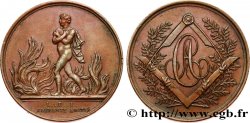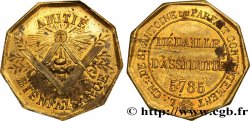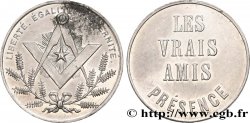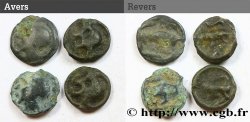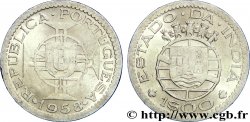E-auction 511-423521 - fjt_755206 - FRANC-MAÇONNERIE - PARIS GRANDE LOGE DE FRANCE 1994
Sie müssen angeschlossen sein und von cgb.fr genehmigt werden, um in einer E-Auktion teilzunehmen.Melden Sie sich an, um zu wetten..Die Kontobestätigungen sind innerhalb von 48 Stunden nach Ihrer Anmeldung gemacht.Warten Sie nicht bis die letzten zwei Tage vor dem Abschluss eines Verkaufs, um Ihre Registrierung abzuschließen. Klickend "BIETEN" verpflichten Sie sich vertraglich, diesen Artikel zu kaufen und Sie nehmen ohne Reserve die allgemeinen Verkaufsbedingungen für den e-auctions zu cgb.fr an.
Der Verkauf wird an der Zeit auf der Übersichtsseite angezeigt geschlossen werden. Angebote, die nach der Schließung Zeit empfangen sind, werden nicht gültig.
Bitte beachten Sie, dass die Fristen für die Einreichung Ihres Angebots auf unsere Server können variieren und es kann zur Ablehnung Ihres Angebots entstehen, wenn es in den letzten Sekunden des Verkaufs gesendet wird. Die Angebote sollen mit ganzer Zahl ausgeführt sein, Sie können Kommas oder des Punktes in Ihrem Angebot nicht erfassen. Bei Fragen klicken Sie hier, um einen Blick auf die FAQ E-Auktionen.
KEINE ANSCHAFFUNGSKOSTEN FÜR DIE KÄUFER.
KEINE ANSCHAFFUNGSKOSTEN FÜR DIE KÄUFER.
| Schätzung : | 20 € |
| Preis : | 14 € |
| Höchstgebot : | 14 € |
| Verkaufsende : | 30 Januar 2023 19:23:30 |
| Bieter : | 4 Bieter |
Type : GRANDE LOGE DE FRANCE
Datum: 1994
Name der Münzstätte / Stadt : PARIS
Metall : Messing
Durchmesser : 29,5 mm
Stempelstellung : 12 h.
Gewicht : 10,97 g.
Rand lisse
Punze : corne
N° im Nachschlagewerk :
Vorderseite
Titulatur der Vorderseite GRANDE LOGE DE FRANCE R.:. E.:. A.:. A.:..
Beschreibung Vorderseite Équerre posée sur un compas , au centre un G.
Rückseite
Titulatur der Rückseite GRANDE LOGE DE FRANCE 1894 - 1994 (CORNE D’ABONDANCE - ROSETTE DE L’ATELIER DE GRAVURE).
Beschreibung Rückseite Oeil dans un triangle rayonnant.
Kommentare
Le centenaire s’explique car en 1894, le Suprême Conseil du Rite Écossais Ancien et Accepté délègue ses pouvoirs sur les trois premiers degrés à la Grande Loge de France ( G.L.F.).
Le centenaire avait d’autant plus d’importance qu’en 1965, devant le refus de la G.L.F. de rompre ses relations avec le Grand Orient (G.O.), un millier de Frères quittèrent la G.L.F dite Puteaux et rejoignent la Grande Loge Nationale Française (G.L.N.F.), dite Bineau, de son ancienne adresse.
Le métal est indéterminé, d’aspect nickelé mais non magnétique, la fabrication est soignée et provient de la Monnaie de Paris qui a signé de la rosette. La tranche est lisse.
La franc-maçonnerie s’implante en France aux alentours du premier quart du XVIIIe s. sous l’influence d’aristocrates anglais. Initiatique, elle est fondée sur le rite hiramique, du nom d’Hiram de Tyr, personnage biblique, architecte du roi Salomon sur le chantier du Temple et qui a résisté à la torture sans livrer ses secrets. Hiram a aussi donné un point de départ du calendrier maçonnique commençant 4000 ans avant le calendrier chrétien. Les symboles servent de signes de reconnaissance entre les initiés, notamment des outils de constructeur de cathédrales (équerre, compas, niveau, maillet, etc.), des formes (triangle, étoile), des nombres (trois, cinq, sept) et des lettres.
The centenary is explained by the fact that in 1894, the Supreme Council of the Ancient and Accepted Scottish Rite delegated its powers over the first three degrees to the Grand Lodge of France (G. L. F. ).
The centenary was all the more important in 1965, given the refusal of the G. L. F. to break off relations with the Grand Orient (G. O. ), a thousand Brothers left the G. L. F called Puteaux and join the French National Grand Lodge (G. L. N. F. ), known as Bineau, from her former address.
The metal is undetermined, nickel-plated but non-magnetic, the manufacturing is careful and comes from the Monnaie de Paris which signed with the rosette. The slice is smooth.
Freemasonry was established in France around the first quarter of the 18th century.. under the influence of English aristocrats. Initiatory, it is based on the Hiramic rite, named after Hiram of Tyre, a biblical character, architect of King Solomon on the construction site of the Temple and who resisted torture without revealing his secrets.. Hiram also gave a starting point for the Masonic calendar beginning 4000 years before the Christian calendar. Symbols serve as signs of recognition between initiates, including cathedral builder tools (square, compass, level, mallet, etc.). ), shapes (triangle, star), numbers (three, five, seven) and letters
Le centenaire avait d’autant plus d’importance qu’en 1965, devant le refus de la G.L.F. de rompre ses relations avec le Grand Orient (G.O.), un millier de Frères quittèrent la G.L.F dite Puteaux et rejoignent la Grande Loge Nationale Française (G.L.N.F.), dite Bineau, de son ancienne adresse.
Le métal est indéterminé, d’aspect nickelé mais non magnétique, la fabrication est soignée et provient de la Monnaie de Paris qui a signé de la rosette. La tranche est lisse.
La franc-maçonnerie s’implante en France aux alentours du premier quart du XVIIIe s. sous l’influence d’aristocrates anglais. Initiatique, elle est fondée sur le rite hiramique, du nom d’Hiram de Tyr, personnage biblique, architecte du roi Salomon sur le chantier du Temple et qui a résisté à la torture sans livrer ses secrets. Hiram a aussi donné un point de départ du calendrier maçonnique commençant 4000 ans avant le calendrier chrétien. Les symboles servent de signes de reconnaissance entre les initiés, notamment des outils de constructeur de cathédrales (équerre, compas, niveau, maillet, etc.), des formes (triangle, étoile), des nombres (trois, cinq, sept) et des lettres.
The centenary is explained by the fact that in 1894, the Supreme Council of the Ancient and Accepted Scottish Rite delegated its powers over the first three degrees to the Grand Lodge of France (G. L. F. ).
The centenary was all the more important in 1965, given the refusal of the G. L. F. to break off relations with the Grand Orient (G. O. ), a thousand Brothers left the G. L. F called Puteaux and join the French National Grand Lodge (G. L. N. F. ), known as Bineau, from her former address.
The metal is undetermined, nickel-plated but non-magnetic, the manufacturing is careful and comes from the Monnaie de Paris which signed with the rosette. The slice is smooth.
Freemasonry was established in France around the first quarter of the 18th century.. under the influence of English aristocrats. Initiatory, it is based on the Hiramic rite, named after Hiram of Tyre, a biblical character, architect of King Solomon on the construction site of the Temple and who resisted torture without revealing his secrets.. Hiram also gave a starting point for the Masonic calendar beginning 4000 years before the Christian calendar. Symbols serve as signs of recognition between initiates, including cathedral builder tools (square, compass, level, mallet, etc.). ), shapes (triangle, star), numbers (three, five, seven) and letters








 Berichten über einen Fehler
Berichten über einen Fehler Die Seite drucken
Die Seite drucken Teilen meiner Auswahl
Teilen meiner Auswahl Stellen Sie eine Frage
Stellen Sie eine Frage Einlieferung/Verkauf
Einlieferung/Verkauf
 Details
Details